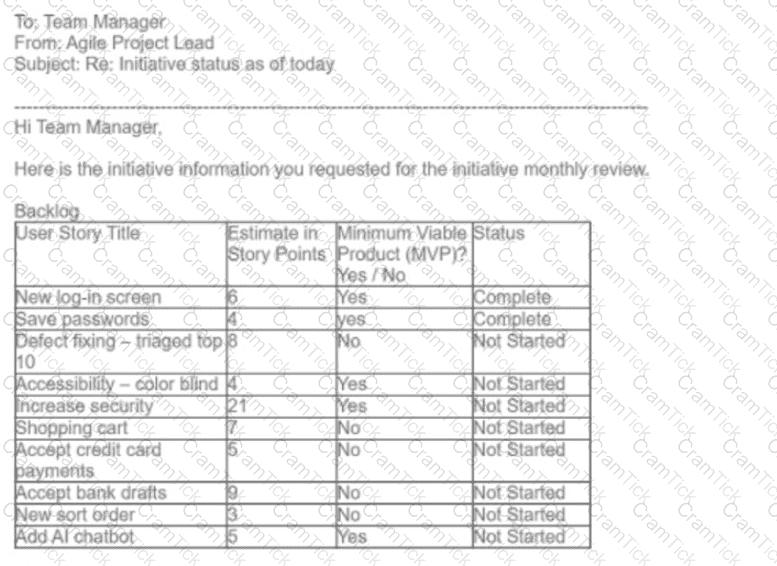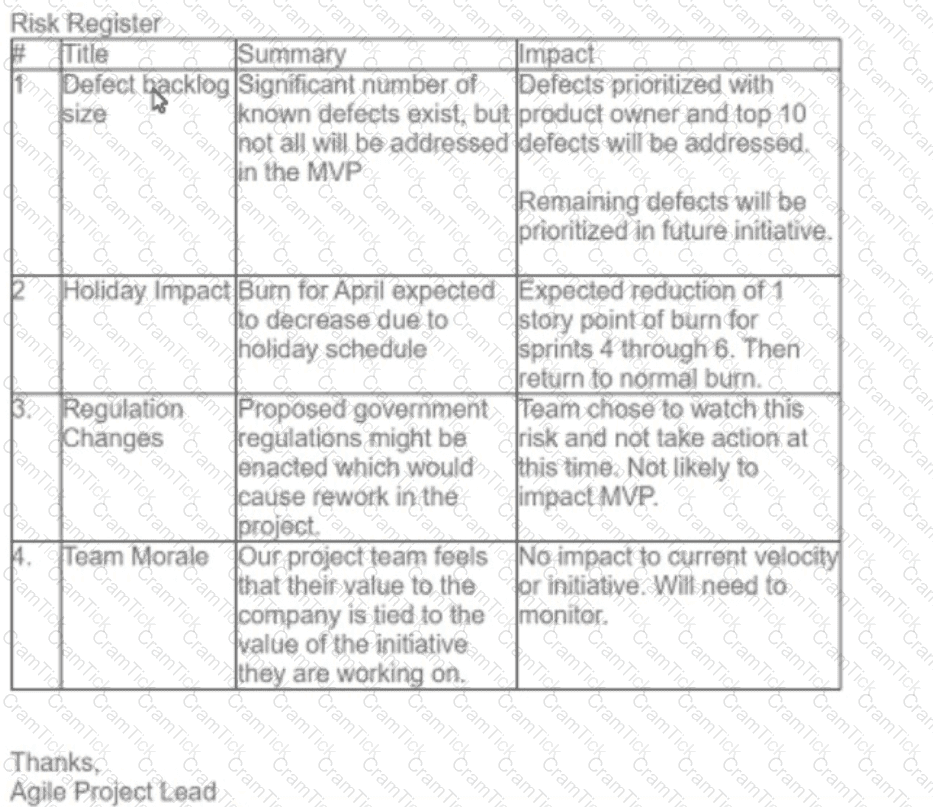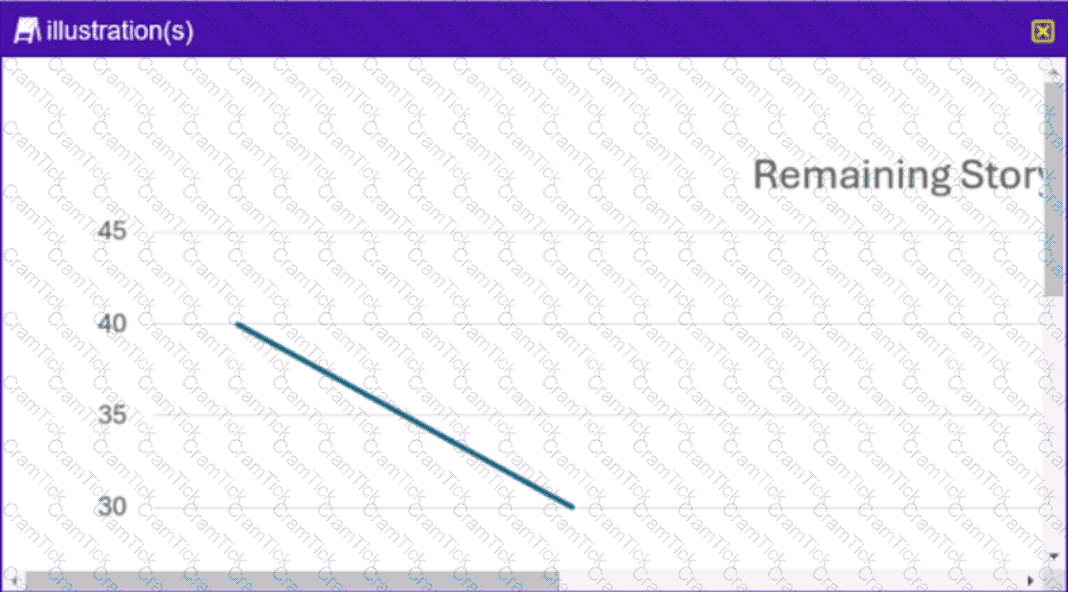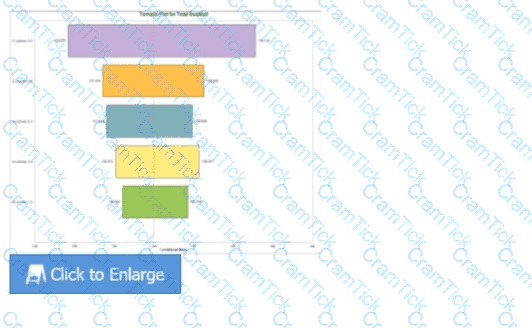The risk manager conducted an updated Monte Carlo simul-ation for the project at the end of a phase. The simul-ation reveals a key activity is now on the critical path.
What recommendation should the risk manager make to the project manager?
A risk manager has noticed that response actions are not working as expected when a risk occurs, mainly because the risk triggers are not well-defined. Which tool should the risk manager use to facilitate risk trigger identification in the upcoming risk review assessment?
At the beginning of a small project, the risk manager facilitates workshops to identify and analyze risks. At the end of the sessions, a stakeholder says that there should be no need to meet again about the risk register now that it's complete since it is such a short and simple project.
How should the risk manager respond to this comment?
in a complex and critical project, a sponsor asks the risk manager to determine where the project's concentration of risks is greatest by performing a quantitative risk analysis. There are no organizational process assets (OPAs)s about the risk categories.
Which tool could the risk manager use to discover the project risk categories?
The project manager leading a company's digital signature initiative for engineering drawings has identified threats and opportunities using a strengths, weaknesses, opportunities, and threats (SWOT) analysis.
What are two potential threats or opportunities under the SWOT analysis? (Choose two.)
What is an example of legal and regulatory requirements and/or constraints when assessing a project environment for threats and opportunities?
A project manager wants to work on understanding the project risks. The project manager works with the integrated project team to develop the risk handling strategies for the identified risks.
How should the project manager work with these risk handling strategies?
The project manager is reviewing the lessons learned from a previous similar project. The previous project was delayed due to the delay in delivery of a gas turbine generator (GTG). Construction of the previous project had to be shut down unexpectedly to wait for the late delivery of the GTG.
What should the project manager do first?
A risk manager is facilitating a risk identification workshop on a new product with technical experts. There is no consensus among the technical experts on most of the identified risks and their characteristics. The risk manager decides to resolve this difference using another technique.
Which technique should the risk manager use in this situation?
A risk manager is preparing risk reports to be included in the monthly status report for project executives. How should the risk manager present the information?
Some issues and unexpected results were found after completing the first phase of a project. The project team is planning the next phase and team members want to avoid the previous issues.
What should the risk manager do to avoid the previous issues?
During a project team meeting, a risk manager realizes that the initial assumptions on the project schedule are too optimistic. The risk manager believes that the project might not meet its deadline as initially stated.
What is the reason for misunderstanding the assumptions from the beginning?
An organization with a large computer network identified a potential cyber security threat. Although certain measures were implemented to avoid the risk, the cyber security threat occurs. The measures were partially successful and a new unforeseen risk emerges.
What should the risk owner do?
A risk manager of a major project facilitates a meeting to develop the risk management plan. What two factors does the risk manager need to consider to ensure an effective risk management plan is developed? (Choose two.)
A list of risks was identified that could occur during the design phase. Now, the team finished the design phase and those risks did not materialize.
What should the project manager do next?
During a brainstorming session, a stakeholder identifies a risk that, if realized, could greatly impact their team. The stakeholder insists that this particular risk should be
mitigated to the greatest extent possible, however, the majority of other stakeholders feel that different risks have higher probabilities of occurring.
Which action should the risk manager take to address this risk?
A project team successfully implemented a risk response plan for a major risk event. Residual risks were evaluated and actions were taken to keep them under control. There were no secondary risks after the implementation.
What should the risk manager do?
Towards the end of definitive design, project costs have increased to the point where it will be classified as a capital asset project. The customer has expressed they want one final total project completion date and will afford no extensions after it is established.
How should the risk manager proceed?
A new company initiates a project to incorporate a cybersecurity team. Which three documents should the risk manager analyze first? (Choose 3)
A new risk manager has been assigned to a project experiencing delays, quality issues, low performance, and client complaints. The work is being completed with the
client's vendor, which apparently has been causing all of the issues.
What should the risk manager do first?
A project team has completed plan risk response activities and has identified three critical risk response plans to major risk events. The responses have been monitored and implemented, with one of the responses presenting the two secondary risks.
What should the risk manager do next?
A risk manager has been assigned to prepare a risk management plan for a new project. Which factor should the risk manager prioritize when tailoring the risk management processes for the new project?
The project team is updating the risk register with the minimum acceptable level of exposure and impact for each risk. The team also wants to determine if they have reached the maximum level of exposure before they escalate the risk.
What should the team perform in this scenario?
A project team has just initiated a large project to move an organization's headquarters to another location. The risk manager has scheduled a risk identification session but notices that the project charter, work breakdown structure (WBS). and scope statement are not available.
What should the risk manager consider?
A risk manager is managing risks of a mission critical application. A subject matter expert (SME) asks the risk manager to treat every single risk identified as an extremely high priority.
What should the risk manager do?
A risk manager has been assigned to a project constructing a chemical laboratory. Unfamiliar with chemical laboratories, the risk manager is unsure of where to start objectively identifying risks.
What should the risk manager do?
Which statement describes the risk portrayed on the risk matrix heat map below?
A project team is concerned about a risk which, if occurs, might add additional complexity to their work. The team will need help from an external vendor, but the contracting process is long.
What should the risk manager do in this case?
A project manager for a predictive project just received a scope change request where additional development is required. What should the risk manager do to support the project manager with this scope change request?
During a meeting with a project team, a project manager asks a risk manager to determine the risk events that could potentially have the most impact on a 2-year project with a budget of US$800 000. Which approach should the risk manager suggest the project manager take?
A project manager has determined that an activity is too complex to complete internally so they hire a licensed contractor to complete the work. What is the project manager performing in this situation?
Some engineers are completing an activity that will alert the project team if there is a risk of requiring additional effort to complete the project. What should the risk manager do in case the trigger arises?
A complex project that had hundreds of risks is almost done. The project manager is closing the risks as part of the closing process. One team member mentions that there are important documents to be updated.
Which document will need to be updated?
During a risk identification session, the risk manager notices that subject matter experts (SMEs) are reluctant to participate because some risks could expose the poor maturity of processes in other business units. Which risk analysis technique should the risk manager use?
After completing the risk register, many team members feel there is a lack of time prioritization for one of the identified risks What are the team members referring to?
There is confusion among risk action owners on a project about when and under which conditions they should initiate risk responses. Project team members often need to consult with the risk manager to get this conflict resolved.
What should the risk manager do to resolve this recurring situation?
A risk manager faces resistance as they try to implement the project's risk strategy. Some members of the project team believe it is a waste of time and money, What should the risk manager do?
A project has suffered a big schedule delay and there are still some risks that are close to materializing. The project manager is concerned about communicating this risk level, because the stakeholders might suspend project funding and cancel the project.
How should the risk manager manage the risk level?
As part of standard procedure to monitor and control a project, a risk manager should constantly update the risk register. The risk register updates should include information on risk reassessment, risk audits, and periodic risk reviews.
What additional information should the risk manager prioritize in the risk register updates?
A project is at the final development stage. The test lead informs the risk manager that a key feature may not be testable due to changes in the environment
What should the risk manager do?
.
A project manager is identifying risks on a project and decides to use a risk checklist to gather historical data accumulated from similar projects. With several different historical project files to choose from, which two pieces of information should the project manager include in their risk checklist? (Choose two.)
A new risk manager has been hired on a project and meets with the project director. The project director supplies the project's risk register and asks the risk manager for an analysis of its effectiveness.
What two actions should the risk manager do next? (Choose two.)
A project manager is working on a complex construction project. During the risk identification process, hundreds of risks were identified. The team seems to be confused regarding on which risks to focus. The project manager advises the team to go ahead and start assessing the likelihood and impact of each risk.
What process is this part of?
A project manager is working on a construction project. Based on past experience, the project manager identifies a risk that a supplier of a critical material may not deliver on time. The project manager has already accounted for this risk in the risk management plan. If this risk materializes, the project manager plans to procure the material from a different supplier. A potential risk in this plan is that there may be differences in the material provided by the first and second supplier.
What type of risk is this?
A risk manager has been assigned to replace a risk manager on sick leave. The new risk manager notices that the risk register is missing data that are key to the risk management process.
Which data will the risk manager require first?
Some project risks are applicable for the project's lifecycle while others risks are only applicable to specific project activities. When should project risks be closed?
A risk manager manages risks in a construction project. A stakeholder mentions that if there is less than a 50% chance of rain, construction should continue. Another stakeholder says that if there is less than a 60% chance of rain, construction should continue.
What should the risk manager do next to find out the correct limit?
Stakeholder holiday schedules and availability of raw materials were two risks initially identified in a manufacturing project. The risk manager now notices that both risks are not quite as originally described and might require a plan change.
What should the risk manager do next?
The project manager has completed four projects all with similar scope. The project manager has recently been assigned to start on a new project and believes some risks may occur again on this project.
What should the project manager do?
A risk manager for a new product development project has worked diligently with stakeholders and the project team to identify and document risks. These project risks vary widely in probability and impact.
Which three actions should the risk manager take to inform the identification of resource requirements for individual risk responses? (Choose 3).
A project team in a multinational organization is working on a risk management plan for a multimillion-dollar project. This project involves three global regions with a wide range of critical stakeholders with varying degrees of risk appetite.
What should the risk manager advise the project team to do?
A risk manager is integrated into a team overseeing a crucial software development project. During the information gathering phase, the risk manager notices significant weaknesses in the maturity of the risk management process. The team needs to establish a more structured approach to managing risks, including the documentation of strategies, ownership structures, and details about the organization's project risk baseline.
What should the risk manager do?
A new project to develop a custom software solution for a high-profile client is being initiated. The project sponsor emphasizes the importance of delivering the solution on time and within budget, as this project could lead to significant future opportunities. The risk manager recognizes that the team lacks a standardized approach to managing risks and that some team members are unfamiliar with risk management practices.
What should the risk manager do?
The project manager performed' a variance analysis on the project during the execution phase. The variances were shown as increasing
What does this result imply?
The risk manager for a large-scale software development project with a tight deadline and multiple stakeholders highlights concerns about potential delays, communication gaps, and vendor reliability. During the early stages of the project, the project sponsor requests that the risk manager identify and address any potential risks that could disrupt project delivery.
What should the risk manager do?
A risk manager has a well-structured risk management process in place for a complex project with a tight schedule. Despite implementing preventive actions, one of the risks identified in the early stages of the project has still occurred and is now an issue.
What should the risk manager do next?
A project manager of an IT company is assigned to a project whose schedule may be delayed due to a lack of resources to conclude the backlog activities. The project manager decides to hire additional developers to reduce the project's technical debt and meet the project deadline.
What should the risk manager advise the project manager to do to address this situation?
The trigger for a highly categorized threat has occurred. The risk has a set response plan.
Who is responsible for developing responses to risk and monitoring the implementation status of the risk response?
An organization is embarking on a multi-million-dollar project with numerous identified risks. What should the project risk team do to navigate the risks on this project?
A risk management professional is currently facilitating the risk planning process with the project team. To increase the breadth of considered risks, the team wants to include high-level and strategic project risks.
What should the risk management professional do next?
In the middle of a project to improve internal workflows, the team realizes that some previously identified challenges, such as lack of stakeholder engagement, have diminished. However, the risk manager determines that concerns related to resource availability and regulatory compliance are becoming more significant.
Which measures should the risk manager implement?
A project team's manager is responsible for delivering a specific initiative for the organization. They are preparing for a monthly meeting where the manager will present on the current state of this initiative. The agile project lead sends the manager the following email with the current initiative status (Refer to the email exhibit).



How many total story points is the entire initiative?
A key project is delayed and all contingency reserves have been used even though the project team has implemented all planned risk responses. What should the risk manager do next?
A project team is overseeing the construction of a new office building. The project is complex, involving multiple contractors, regulatory requirements, and a tight schedule. During a team meeting, the risk manager realizes that a formal risk identification exercise has not yet been conducted.
Given the project's complexity, what should the risk manager do?
A new vice president in one of its divisions observed that the portfolio of projects within their division experienced significant variations beyond the ±10% established threshold with the potential of not achieving its overall business goals. Hence, they directed all project leaders and sponsors to ensure that they set and work toward more stringent thresholds of ±5% and reports on the basis of any variance outside that range.
How should the risk manager respond?
A risk manager administered a pre-workshop risk survey in preparation for the upcoming workshop. The workshop invitees participated in the survey and submitted many risks encompassing all project phases and risk areas. The risk manager sorts risks by similarities and categories for the workshop.
What should the risk manager do next to visually organize the risks?
A risk management team has completed a quantitative analysis, and the individual score in terms of schedule and cost has been identified. The team is consolidating inputs for contingency planning and notices that the available time and funds are not sufficient for all the risks.
What should the risk manager advise the project team?
A two-year project with a budget of US$2 million has completed about 60% of the work at the end of the first year. The actual cost incurred to complete the remaining 40% of work is about USS1.5 million. As a part of performing a specialized risk analysis, the calculated schedule performance index (SPI) is 1.2 and cost performance index (CPI) is 0.53.
How should the risk manager interpret such a low CPI value?
The risk manager notices that in their workshops, most of the risks identified are threats. What should the risk manager do to increase the number of opportunities identified?
During a project's initial planning session, the project team identifies a possible risk. The team is under the impression that a critical vendor might delay delivery. This could impact both the project schedule and budget. The team shares insights on the risk's likelihood and impact with the risk manager.
What should the risk manager do?
An organization that spans across different countries undergoes a digital transformation project. The project manager has assigned a risk management team leader who is a risk management certified candidate in their domain.
What should the risk management team leader do in the early stages of the project?
During the construction of a housing development, a project team realizes they exceeded their materials budget during the first of three execution stages. The risk manager observed that the team did not notice that the cost of the materials increased due to continuous inflation in the steel market.
What could have been done during project planning to avoid overspending?
A certain risk is identified for a major project, and the risk response is planned. However, the analysis reveals a high probability for a secondary risk which will be tolerated based on the organization's risk thresholds. The secondary risk is subsequently registered. During project execution, the primary risk occurs, the planned action is taken, and the secondary risk emerges
What two actions should the risk owner take? (Choose two.)
There is a debate within the organization on whether projects need to be agile or waterfall. Some agile terms and principles are understood differently by the key stakeholders, and this delays the decision-making process.
A project team is discussing which risk requires more attention and resources for response planning. The team evaluated the schedule to determine which activity had the greatest impact on the project's total duration.
After analyzing the quantitative analysis results, which activity should the team pay more attention to?
Use the chart for the analysis.

During the project's lifecycle, project risk managers must monitor any risks and address risk responses. What does this level of monitoring consist of?
PMI Certification | PMI-RMP Questions Answers | PMI-RMP Test Prep | PMI Risk Management Professional Questions PDF | PMI-RMP Online Exam | PMI-RMP Practice Test | PMI-RMP PDF | PMI-RMP Test Questions | PMI-RMP Study Material | PMI-RMP Exam Preparation | PMI-RMP Valid Dumps | PMI-RMP Real Questions | PMI Certification PMI-RMP Exam Questions


